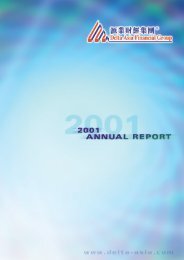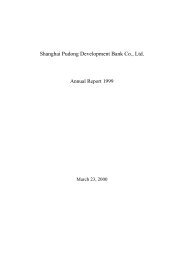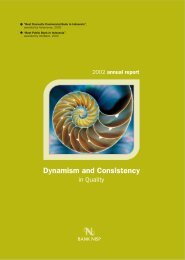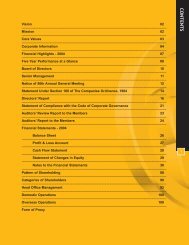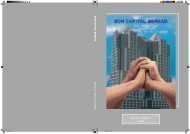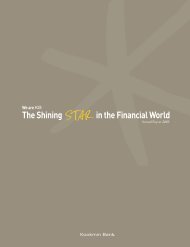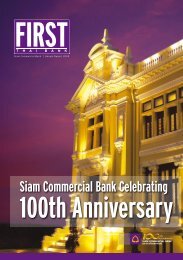Banco de Oro Universal Bank provides a - Asianbanks.net
Banco de Oro Universal Bank provides a - Asianbanks.net
Banco de Oro Universal Bank provides a - Asianbanks.net
- No tags were found...
You also want an ePaper? Increase the reach of your titles
YUMPU automatically turns print PDFs into web optimized ePapers that Google loves.
2005 ANNUAL REPORT45• Termination BenefitsTermination benefits are payable when employment is terminated by the Group before the normal retirement date, or wheneveran employee accepts voluntary redundancy in exchange for these benefits. The Group recognizes termination benefits when it is<strong>de</strong>monstrably committed to either: (a) terminating the employment of current employees according to a <strong>de</strong>tailed formal planwithout possibility of withdrawal; or (b) providing termination benefits as a result of an offer ma<strong>de</strong> to encourage voluntaryredundancy. Benefits falling due more than 12 months after the statement of condition date are discounted to present value.• Bonus PlansThe Group recognizes a liability and an expense for bonuses based on the Group’s bonus policy. The Group recognizes a provisionwhere it is contractually obliged to pay the benefits.• Compensated AbsencesCompensated absences are recognized for the number of paid leave days (including holiday entitlement) remaining at the statementof condition date. They are inclu<strong>de</strong>d in Other Liabilities account at the undiscounted amount that the Group expects to pay as aresult of the unused entitlement.3.22 Income TaxesCurrent income tax assets or liabilities comprise those claims from, or obligations to, fiscal authorities relating to the current or prior reportingperiod, that are uncollected or unpaid at the statement of condition date. They are calculated according to the tax rates and tax lawsapplicable to the fiscal periods to which they relate, based on the taxable profit for the year. All changes to current tax assets or liabilities arerecognized as a component of tax expense in the statements of income.Deferred tax is provi<strong>de</strong>d, using the balance sheet liability method, on temporary differences at the statement of condition date between thetax base of assets and liabilities and their carrying amounts for financial reporting purposes.Un<strong>de</strong>r the balance sheet liability method, with certain exceptions, <strong>de</strong>ferred tax liabilities are recognized for all taxable temporary differencesand <strong>de</strong>ferred tax assets are recognized for all <strong>de</strong>ductible temporary differences and the carryforward of unused tax losses and unused taxcredits to the extent that it is probable that taxable profit will be available against which the <strong>de</strong>ferred tax asset can be utilized.The carrying amount of <strong>de</strong>ferred tax assets is reviewed at each statement of condition date and reduced to the extent that it is probable thatsufficient taxable profit will be available to allow all or part of the <strong>de</strong>ferred tax asset to be utilized.Deferred tax assets and liabilities are measured at the tax rates that are expected to apply to the period when the asset is realized or theliability is settled, based on tax rates and tax laws that have been enacted or substantively enacted at the statement of condition date.Most changes in <strong>de</strong>ferred tax assets or liabilities are recognized as a component of tax expense in the statements of income. Only changes in<strong>de</strong>ferred tax assets or liabilities that relate to a change in value of assets or liabilities that is charged directly to capital funds.3.23 Capital FundsCommon stock is <strong>de</strong>termined using the nominal value of shares that have been issued.Common stock option pertains to the value of the segregated equity component of the convertible loan as required un<strong>de</strong>r PAS 32: FinancialInstruments: Disclosures and Presentation.Treasury shares inclu<strong>de</strong> the cost of the parent company’s shares of stock which were acquired by a subsidiary.Additional paid-in capital inclu<strong>de</strong>s any premiums received on the issuance of capital stock. Any transaction costs associated with the issuanceof shares are <strong>de</strong>ducted from additional paid-in capital.Surplus reserves pertain to a portion of the <strong>Bank</strong>’s income from trust operations set-up on a yearly basis in compliance with BSP regulationsand appropriation for general banking risks.Surplus free inclu<strong>de</strong>s all current and prior period results as disclosed in the statements of income.Fair value gain (loss) on available-for-sale financial assets pertains to cumulative mark-to-market valuation of available-for-sale financial assets.3.24 Earnings Per Share (EPS)Basic earnings per common share is <strong>de</strong>termined by dividing <strong>net</strong> income by the weighted average number of common shares subscribed andissued during the period, after retroactive adjustment for any stock divi<strong>de</strong>nd <strong>de</strong>clared in the current period.Diluted earnings per common share is also computed by dividing <strong>net</strong> income by the weighted average number of common shares subscribedand issued during the period. However, <strong>net</strong> income attributable to common shares and the weighted average number of common sharesoutstanding are adjusted to reflect the effects of potentially dilutive convertible loan. Convertible loan is <strong>de</strong>emed to have been convertedinto common shares at the start of the conversion period.



